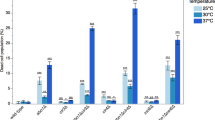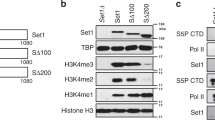Abstract
The Sir3 protein helps form telomeric heterochromatin by interacting with hypoacetylated histone H4 lysine 16 (H4–Lys16). The molecular nature of the heterochromatin boundary is still unknown. Here we show that the MYST-like acetyltransferase Sas2p is required for the acetylation (Ac) of H4–Lys16 in euchromatin. In a sas2Δ strain or a phenocopy Lys16Arg mutant, Sir3p spreads from roughly 3 kb to roughly 15 kb, causing hypoacetylation and repression of adjacent chromatin. We also found that disruption of Sir3p binding in a deacetylase-deficient Sir 2Δ strain can be suppressed by sas2Δ. These data indicate that opposing effects of Sir2p and Sas2p on acetylation of H4–Lys16 maintain the boundary at telomeric heterochromatin.
This is a preview of subscription content, access via your institution
Access options
Subscribe to this journal
Receive 12 print issues and online access
$209.00 per year
only $17.42 per issue
Buy this article
- Purchase on Springer Link
- Instant access to full article PDF
Prices may be subject to local taxes which are calculated during checkout






Similar content being viewed by others
References
Braunstein, M., Rose, A.B., Holmes, S.G., Allis, C.D. & Broach, J.R. Transcriptional silencing in yeast is associated with reduced nucleosome acetylation. Genes Dev. 7, 592–604 (1993).
Suka, N., Suka, Y., Carmen, A.A., Wu, J. & Grunstein, M. Highly specific antibodies determine histone acetylation site usage in yeast heterochromatin and euchromatin. Mol. Cell 8, 473–479 (2001).
Moretti, P., Freeman, K., Coodly, L. & Shore, D. Evidence that a complex of Sir proteins interacts with the silencer and telomere-binding protein RAP1. Genes Dev. 8, 2257–2269 (1994).
Grunstein, M. Molecular model for telomeric heterochromatin in yeast. Curr. Opin. Cell Biol. 9, 383–387 (1997).
Johnson, L.M., Kayne, P.S., Kahn, E.S. & Grunstein, M. Genetic evidence for an interaction between Sir3p and histone H4 in the repression of the silent mating loci in Saccharomyces cerevisiae. Proc. Natl Acad. Sci. USA 87, 6286–6290 (1990).
Megee, P.C., Morgan, B.A., Mittman, B.A. & Smith, M.M. Genetic analysis of histone H4: essential role of lysines subject to reversible acetylation. Science 247, 841–845 (1990).
Carmen, A.A., Milne, L. & Grunstein, M. Acetylation on the yeast histone H4 N terminus regulates its binding to heterochromatin protein Sir3p. J. Biol. Chem. 277, 4778–4781 (2002).
Lachner, M., O'Carroll, D., Rea, S., Mechtler, K. & Jenuwein, T. Methylation of histone H3 lysine 9 creates a binding site for HP1 proteins. Nature 410, 116–120 (2001).
Bannister, A.J. et al. Selective recognition of methylated lysine 9 on histone H3 by the HP1 chromo domain. Nature 410, 120–124 (2001).
Litt, M.D., Simpson, M., Gaszner, M., Allis, C.D. & Felsenfeld, G. Correlation between histone lysine methylation and developmental changes at the chicken β-globin locus. Science 293, 2453–2455 (2001).
Nakayama, J., Rice, J.C., Strahl, B.D., Allis, C.D. & Grewal, S.I. Role of histone H3 lysine 9 methylation in epigenetic control of heterochromatin assembly. Science 292, 110–113 (2001).
Strahl, B.D., Ohba, R., Cook, R.G. & Allis, C.D. Methylation of histone H3 at lysine 4 is highly conserved and correlates with transcriptionally active nuclei in Tetrahymena. Proc. Natl Acad. Sci. USA 96, 14967–14972 (1999).
Strahl, B.D. et al. Set2 is a nucleosomal histone H3-selective methyltransferase that mediates transcriptional repression. Mol. Cell. Biol. 22, 1298–1306 (2002).
Donze, D. & Kamakaka, R.T. RNA polymerase III and RNA polymerase II promoter complexes are heterochromatin barriers in Saccharomyces cerevisiae. EMBO J. 20, 520–531 (2001).
Clarke, D.J., O'Neill, L.P. & Turner, B.M. Selective use of H4 acetylation sites in the yeast Saccharomyces cerevisiae. Biochem J. 294, 557–561 (1993).
Grunstein, M. Yeast heterochromatin: regulation of its assembly and inheritance by histones. Cell 93, 325–328 (1998).
Reifsnyder, C., Lowell, J., Clarke, A. & Pillus, L. Yeast SAS silencing genes and human genes associated with AML and HIV-1 Tat interactions are homologous with acetyltransferases. Nat. Genet. 14, 42–49 (1996).
Akhtar, A. & Becker, P.B. Activation of transcription through histone H4 acetylation by MOF, an acetyltransferase essential for dosage compensation in Drosophila. Mol. Cell 5, 367–375 (2000).
Smith, E.R. et al. The Drosophila MSL complex acetylates histone H4 at lysine 16, a chromatin modification linked to dosage compensation. Mol. Cell. Biol. 20, 312–318 (2000).
Imai, S., Armstrong, C.M., Kaeberlein, M. & Guarente, L. Transcriptional silencing and longevity protein Sir2 is an NAD-dependent histone deacetylase. Nature 403, 795–800 (2000).
Clarke, A.S., Lowell, J.E., Jacobson, S.J. & Pillus, L. Esa1p is an essential histone acetyltransferase required for cell cycle progression. Mol. Cell. Biol. 19, 2515–2526 (1999).
Renauld, H. et al. Silent domains are assembled continuously from the telomere and are defined by promoter distance and strength, and by Sir3p dosage. Genes Dev. 7, 1133–1345 (1993).
Hecht, A., Strahl-Bolsinger, S. & Grunstein, M. Spreading of transcriptional repressor Sir3p from telomeric heterochromatin. Nature 383, 92–96 (1996).
Strahl-Bolsinger, S., Hecht, A., Luo, K. & Grunstein, M. Sir2 and Sir4 interactions differ in core and extended telomeric heterochromatin in yeast. Genes Dev. 11, 83–93 (1997).
Johnson, L.M., Fisher-Adams, G. & Grunstein, M. Identification of a non-basic domain in the histone H4 N-terminus required for repression of the yeast silent mating loci. EMBO J. 11, 2201–2209 (1992).
Hecht, A., Laroche, T., Strahl-Bolsinger, S., Gasser, S.M. & Grunstein, M. Histone H3 and H4 N-termini interact with Sir3p and Sir4p proteins: a molecular model for the formation of heterochromatin in yeast. Cell 80, 583–592 (1995).
Kimura, A., Umehara, T. & Horikoshi, M. Chromosomal gradient of histone acetylation established by Sas2p and Sir2p functions as a shield against gene silencing. Nat. Genet. 32 (2002); advance online publication, 15 October 2002 (doi:10.10138/993).
Fourel, G., Revardel, E., Koering, C.E. & Gilson, E. Cohabitation of insulators and silencing elements in yeast subtelomeric regions. EMBO J. 18, 2522–2537 (1999).
Robyr, D. et al. Microarray deacetylation maps determine genome-wide functions for yeast histone deacetylases. Cell 109, 437–446 (2002).
Gu, W., Wei, X., Pannuti, A. & Lucchesi, J.C. Targeting the chromatin-remodeling MSL complex of Drosophila to its sites of action on the X chromosome requires both acetyl transferase and ATPase activities. EMBO J. 19, 5202–5211 (2000).
Wach, A. et al. PCR-based gene targeting in Saccharomyces cerevisiae. Method in Microbiology Vol. 26 (eds Brown, P.D.P. & Tuite, M.F.) 67–81 (Academic, London, 1998).
Vogelauer, M., Wu, J., Suka, N. & Grunstein, M. Global histone acetylation and deacetylation in yeast. Nature 408, 495–498 (2000).
Brown, A.J.P., Furness, L.M. & Bailey, D. Transcript analysis. Method in Microbiology Vol. 26 (eds Brown, P.D.P. & Tuite, M.F.) 119–139 (Academic, London, 1998).
Acknowledgements
We thank L. Pillus for the esa1ts strain and the members of M.G.'s laboratory for critical comments and discussions throughout this work. This work was supported by a Public Health Service grant from the U.S. National Institutes of Health.
Author information
Authors and Affiliations
Corresponding author
Ethics declarations
Competing interests
The authors declare no competing financial interests.
Rights and permissions
About this article
Cite this article
Suka, N., Luo, K. & Grunstein, M. Sir2p and Sas2p opposingly regulate acetylation of yeast histone H4 lysine16 and spreading of heterochromatin. Nat Genet 32, 378–383 (2002). https://doi.org/10.1038/ng1017
Received:
Accepted:
Published:
Issue Date:
DOI: https://doi.org/10.1038/ng1017
This article is cited by
-
Acetylation of PAX7 controls muscle stem cell self-renewal and differentiation potential in mice
Nature Communications (2021)
-
Gene repression in S. cerevisiae—looking beyond Sir-dependent gene silencing
Current Genetics (2021)
-
Structure and function of the Orc1 BAH-nucleosome complex
Nature Communications (2019)
-
Pre-existing H4K16ac levels in euchromatin drive DNA repair by homologous recombination in S-phase
Communications Biology (2019)
-
Integrative analysis reveals functional and regulatory roles of H3K79me2 in mediating alternative splicing
Genome Medicine (2018)



